Every spring, summer car welding and other hot work causes unnecessary fires. A high risk of fire is caused, for example, by failure to protect the working environment. This spring, a few fires have already been caused by hot work related to car repair, and more are likely to be expected. Last year, a total of 25 car repair fires broke out. Experts from the Finnish National Rescue Association have some practical advice on how to avoid the last-minute burning of the car you wanted to repair.

There were 25 fires related to car tuning last year, and 21 the year before. The numbers are not that large, but the loss of a beloved car can be upsetting, and the fire could also cost lives or cause damage to other property. Finnish National Rescue Association offers safety information on how to avoid car repair fires this spring. Many car enthusiasts are already anxious to get behind the wheel of their summer cars, but there are a few things you could do to ensure that you eventually get on the road safely.
‘A large number of the fires are caused by failure to ensure the protection and tidiness of the working environment. If you’re using an angle grinder, the working area must be protected with a special spark protection fabric or, for example, a protective shield made of sheet metal, to prevent sparks from spreading and starting a fire,’ says Heli Hätönen, Head of Training at Finnish National Rescue Association.
It is also a good idea to inspect the environment before starting. Fires have been started, for example, when welding sparks or splatters have set fire to oil or debris on the floor. In addition to protection, the car tuner should also be aware of how heat behaves. When metal heats up, the heat is conducted in the metal. That is why, for example, the upholstery of the car should be removed and the petrol in the fuel tank replaced with water, if welding work is done near them.
Welding is not permitted in garages
Insurance companies’ terms and conditions usually forbid welding and other hot work in garages and carports. The warehouses and recreational facilities of apartment buildings are also not suitable for the purpose, as they are not designed to withstand fire hazardous or potentially explosive activities.
Where, then, can welding be done, if not near a residential building? Is a barn-connected warehouse or a hangar okay, if the tuning area is separated from other areas with a Gyproc plasterboard or a fire-resistant curtain? According to Ms Hätönen, this depends on the terms and conditions of the property insurance, which should always be reviewed before starting.
Outdoor spaces are often easier but pose a risk of grass or forest fires. No hot work should be done in windy weather or during grass and forest fire warnings. A bigger sand or asphalt area would be ideal, provided that there are no buildings nearby. A distance of 15–20 meters to buildings and other cars is not exaggeration, as sparks can fly for up to tens of meters. However, it is important to stop sparks from spreading from the hot work area.
What if you just can’t wait to get on the open road with your fabulous summer car? Can’t safety be compromised just a little bit, if you’re in a hurry and have a spring in your step?
‘As a car enthusiast, you’ve probably already put a lot of time and effort into renovating the car, so for goodness’ sake, don’t burn it now!’, Ilpo Leino, Senior Specialist at Finnish National Rescue Association, cries out. ‘People eager to ride the car and even your buddy’s car may also be at risk, if you tune them together and sparks start to spread,’ Mr Leino says.
Speaking of sparks spreading, the Rescue Association’s experts have some practical advice to offer on that, too. The angle grinder can be directed so that the sparks cannot fly far, and the interior of the car can be protected with a fire-resistant fabric. A fire blanket won’t work, however, as the sparks will burn through it.
Reserve enough time for post-control
Even if you have adhered to all of these welding safety measures, you cannot leave the area immediately after you’ve finished your work. The experts from Finnish National Rescue Association recommend monitoring the area for smouldering for at least an hour after you’ve finished.
‘You may not notice a smouldering fire until it bursts into flames’, reminds Ms Hätönen.
‘It is also advisable to keep first-aid fire extinguishing equipment nearby and practice using them in advance, so that you won’t put yourself in danger,’ she continues.
10 things car enthusiasts should know about safe tuning
- Check the insurance company’s terms and conditions about the safety regulations.
- Hot work, such as welding, cannot be done in a garage or inside or near a residential building.
- When welding, other vehicles must be far enough away, the upholstery of the car should be removed as much as needed, the petrol tank should be removed or filled with water, and the tyres should be protected or removed.
- Remove all combustible materials and liquids as well as gas cylinders from the working area.
- When tuning the car outdoors, consider the risk of forest or grass fires and check the warnings issued by the Finnish Meteorological Institute: ilmatieteenlaitos.fi/varoitukset.
- Sparks can fly for tens of meters.
- Direct the angle grinder so that the sparks cannot fly far.
- A fire-resistant fabric can be used as a protective cover to prevent sparks from flying to the surrounding environment. A fire blanket won’t do, as the sparks will burn through it.
- Have some water and first-aid fire extinguishing equipment nearby and learn how to put out a starting fire.
- Do not weld just before you’re about to leave, but watch the car and the surrounding area for at least an hour, even longer if necessary.
